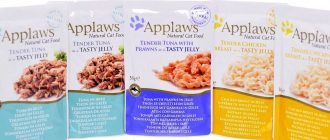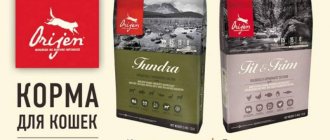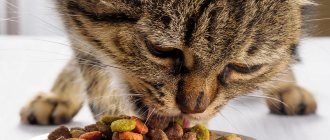Industrially prepared cat food does not require much time and effort from you; it is easy to purchase and give to your pet. This is especially important and convenient during a busy work schedule. However, one cannot ignore the fact that some of these processed foods may be harmful to your cat's health. That's why more and more pet owners are choosing to switch from commercially produced foods to a more natural diet for their pets.
Specially prepared homemade cat food, made from fresh and healthy ingredients, can be, if not the basis, then a pleasant and healthy addition to your pet’s diet. In addition, such food is much more natural, it is closer to the natural diet of cats than anything offered in pet stores.
Choose protein-rich recipes
Owners should be aware that cats need a lot of protein (they need 5 times more protein than dogs), which inevitably means that a dog's food may not be a normal diet for a cat. For each type of animal (for example, cats, dogs, chinchillas), it is necessary to prepare separately. There are many simple and affordable recipes that can be used to provide complete and balanced nutrition for your cat.
Of course, as we all know, cats are picky eaters, so there is no guarantee that they will like all the recipes, but there are sure to be some that they will like. The main thing is to start with what your cat likes and what smells good.
Carbohydrates and fiber in natural foods
To replenish this important nutritional element and ensure high-quality digestion of food with a natural diet, raw, boiled, steamed vegetables, fruits and berries must be included in the cat’s diet.
Not all animals are attracted to the taste of apples, greens, cranberries, blueberries, legumes, and carrots. You can add a little sunflower or olive oil to this food, and also mix it with pieces of meat or puree.
Preference should be given to cauliflower, broccoli, lettuce, zucchini, pumpkin, and apples. But some vegetables are on the list of prohibited foods (more on that below) and are not recommended for cats. Oatmeal and pearl barley porridge can be included in the diet of pets. It is not recommended to give semolina porridge, i.e. wheat.
Use a variety of meat sources
The more there are, the better (chicken, turkey, beef, rabbit, duck, etc.). This provides a more complete balance of nutrients and also enriches the feeding with different tastes and textures. You can use different sources of meat at the same time.
There are different opinions regarding the use of bones in preparing cat food. Personally, I never use them due to the risk of choking, puncture or blocking the digestive tract.
Approximate diet
Indicated for an adult cat for 3 days, products are indicated in grams.
| Day | Breakfast | Dinner | Dinner |
| First | Kefir (10), broccoli puree (15), cottage cheese (40), butter (3). | Chicken (60). | Cottage cheese (40), rabbit meat (70). |
| Second | Raw egg (1 piece), cottage cheese (30). | Chicken giblets (heart, 30), cottage cheese (40). | Minced chicken (80), vegetables (10), vegetable oil (3). |
| Third | Boiled fish (50), vegetables (15). | Cottage cheese (40), kefir (20). | Veal (80), kefir (20). |
Add products containing tatourine
The heart of various animals should be added to the diet, as it is one of the best sources of taurine, which is an essential amino acid for cats. If you do not give your cat enough hearts (about 10% of the diet), additional taurine must be given in the form of food supplements.
The menu should also include the liver or another secretory organ (for example, kidneys and spleen). Most animals do not like their taste, but it can be masked by chopping and mixing with meat and vegetables. Among the vegetables you can give pumpkin, spinach, carrots, etc. Onions and garlic are toxic to cats and should not be given to them.
You will also need a blender, food processor or meat grinder for cooking.
The basic formula for cat food is simple: half protein (meat) and one-quarter each carbohydrates (grains) and vegetables (fiber).
Protein is found in turkey, chicken, rabbit, fish and other meats. The best source of carbohydrates is brown rice. As for vegetables, whatever your cat eats is fine. The meat can be either raw or boiled. Mix it with cooked vegetables and rice.
Principles of natural nutrition
With natural feeding, pets do not receive nutritious industrial mixtures, but products prepared by humans themselves. Such food must meet certain requirements:
- Completely meet the cat's needs for basic and additional nutrients.
- Be safe for your pet, that is, do not contain pathogenic bacteria and parasites.
- Natural food must not contain substances harmful to cats - GMOs, hormones, pesticides, components that are contraindicated for pets.
If you don’t know what diet is best to choose for your pet, we recommend reading the article on cat nutrition on our portal.
The diet of animals must include:
- Squirrels. A predator, which is a cat, must obtain this element mainly from meat (about 80% of the diet).
- Fats. Preference should be given to products of animal origin, while the plant component, although in a smaller part, is necessary.
- Carbohydrates. They are a source of energy for any mammal, so they must be in a cat’s diet every day, but in small quantities.
- Cellulose. Ensures proper functioning of the gastrointestinal tract and complete digestion of food, therefore it is a mandatory ingredient in the daily diet with a natural diet.
- Vitamins, micro- and macroelements. They compensate for the lack of calcium, phosphorus, magnesium, iodine, selenium, and other components that provide the animal with healthy skin, coat, and proper functioning of the cardiovascular and musculoskeletal systems.
- Water. It should always be present in the cat’s natural diet in its pure form and in unlimited quantities.
When feeding a natural diet, it is important to ensure that the cat does not have vitamin deficiency, in order to notice this condition in time, read the article here.
And now some recipes for homemade cat food
They are collected from various sources on the Internet. Anything you prepare for your cat yourself (with a few exceptions, of course) will be better than what you can buy in the store, because not only do you have complete control over all the ingredients, but also because you are directly involved in the process. Cats, like people, appreciate home-cooked food prepared with love just for them.
Chicken with rice and vegetables
- 2 cups chopped or shredded chicken
- 1 cup cooked brown rice
- 1/4 cup grated boiled carrots
Cut the chicken into small pieces. Pass the carrots through a food processor. Mix chicken and carrots with rice. Serve at room temperature.
Diet for a picky cat
- 1 cup boiled chicken
- 1/4 cup steamed broccoli
- 1/4 carrots, steamed
- Chicken broth, about half a cup
Mix ingredients and serve.
Salmon with rice
- 150 gr. steamed salmon
- 1/2 hard-boiled egg
- 1/3 cup boiled rice
- 1 tablet calcium carbonate (400 mg calcium)
- 1 tablet of vitamin-mineral complex
Mix and serve.
Liver holiday
- 2 cups chopped beef or chicken liver
- 2 tablespoons vegetable oil
- 1 cup cooked oatmeal
- 1/4 cup frozen peas, steamed
Boil the liver with vegetable oil, chop finely. Add cooked oatmeal and green peas. Cool and serve at room temperature.
From what is
- 1.5 cups meat - beef, chicken, turkey, lamb (finely chopped)
- 0.5 cups of vegetables - carrots, zucchini, sweet potatoes, pumpkin or wheat germ
- 0.5 cups mashed potatoes, rice or oatmeal
- 1 tablespoon vegetable oil
Pass vegetables through a food processor. Chop the meat finely. Mix meat and vegetables, potatoes, rice or oatmeal. Add vegetable oil and serve.
Tuna for lunch
- 0.5 kg. tuna, canned in oil
- 1/2 cup cooked brown rice
- 1/4 cup grated carrots
- 2 tablespoons sprouted wheat
Mix and serve at room temperature. Do not give more than once a week as it may lead to vitamin E deficiency.
Liver and kidneys for dinner
- 1 cup boiled chopped liver or kidneys
- 3/4 cup boiled oatmeal
- 3 tablespoons grated carrots or zucchini
- 1/3 cup yogurt
- 3 tablespoons butter
Mix minced liver or kidneys, oatmeal and vegetables. Melt the butter and pour in the mixture. Add yogurt and serve at room temperature.
Holiday
- 1 cup shredded beef
- 1/4 cup alfalfa or parsley
- 1/2 cup cottage cheese with cream
Mix the ingredients.
Diet for allergies
- 2 cups shredded lamb
- 1/2 cup grated carrots or zucchini
- 1 cup cooked brown rice
- 1/4 cup cottage cheese
- 1/4 tsp. garlic powder
Combine all ingredients in a blender and serve at room temperature.
Dinner time
- 100 gr. cooked white meat chicken
- 1/4 cup cooked mashed potatoes
- 1-1/2 teaspoons butter
Combine all ingredients in a blender and serve at room temperature.
For breakfast
- 1 egg
- 1 tablespoon green beans (cooked or pureed)
- 1 tablespoon finely chopped carrots
- 2 tablespoons chopped chicken breasts (skinless)
- 1/3 cup brown rice (cooked)
- 1 tablespoon olive oil
Mix all ingredients thoroughly. You can also puree the mixture in a blender if needed.
Stewed chicken for cats
- 1 whole chicken
- 2 cups brown rice
- 6 stalks of celery
- 6 carrots, grated but not peeled
- 2 small yellow pumpkins
- 2 zucchini
- 1 cup green peas
- handful of green beans
Wash the chicken, then cover with water in a large saucepan and simmer. Cut the vegetables into pieces and add to the pan. Add rice. Cook until the chicken is almost falling off the bones and the vegetables are tender. Remove the chicken completely from the bones. This is very important because cooked chicken bones can cause serious intestinal damage. Pour everything into a blender and grind the mixture.
Chicken liver recipe
- 1/2 cup cooked broccoli or cooked carrots
- 1/2 cup cooked rice
- 1 1/2 cups boiled chicken liver
- Chicken liver broth
Place rice, liver, broccoli or carrots in a blender and blend them, adding a little broth.
Chicken with broccoli
- A piece of skinless, boneless chicken breast about the size of your palm or smaller, depending on how much you want to cook.
- Two or three pieces of broccoli
Boil the chicken and broccoli, mix in a blender until smooth.
Shrimp with carrots
- 3-4 raw shrimp. You need to cut off the tail and remove the outer layer, boil it.
- The carrots will need to be cooked over high heat for 10-15 minutes, then blend them in a blender until smooth.
Once the shrimp have cooled slightly, cut them into small pieces. Mix with carrots.
Meat with cottage cheese
- 100 gr. meat, beef or poultry
- 1 tablespoon carrots
- 1 tablespoon cottage cheese
- 1 tablespoon sunflower oil.
You can also add flavorings to your food (kelp powder, garlic powder, nutritional yeast), but only in small quantities.
You can store leftover cat food in the refrigerator, but the same rules apply as leftover human food—use within a few days or freeze.
How to accustom a cat to new food
When changing your diet, a smooth transition is necessary. This way you can avoid digestive disorders.
Rules for transferring to a new diet:
- gradually reduce portions of the previous food;
- increase the amount of natural product;
- for training, use one recipe for homemade food, only after getting used to it, add new products;
- During the first days you should monitor your pet; if digestive problems arise, change the components of the homemade food;
- if you have a poor appetite, it is permissible to feed by hand or warm it up to a slightly warm state (the cat is a predator and for it the normal food temperature is the temperature of a freshly killed carcass).
You can switch the animal to natural food within 1-2 weeks.
Feeding rules
To keep your animal healthy, it is important to follow basic nutritional rules:
- The pet should be fed at the same time, 2-3 times a day. Kittens should be fed 5-6 times a day.
- Provide access to water around the clock.
- If symptoms such as vomiting, diarrhea, lethargy, or fever appear, contact your veterinarian immediately.
- After eating, the cat often requires rest; you should not disturb it.
- Uneaten food must be disposed of - it quickly deteriorates and becomes dangerous for the animal, in addition, with constant access to food, cats can overeat.
Be sure to read:
What is cat food made from: how is it made wet and dry, can you make it yourself?
It is better to discuss the composition of homemade food with your veterinarian. He will suggest the most balanced types of nutrition, taking into account the characteristics of the pet. Food for kittens, adult cats or sterilized animals differs in composition. All ingredients must be fresh and of high quality.
How to cook food for a cat
All components must be heat treated. The meat can be thoroughly frozen. Veterinarians do not recommend adding raw meat purchased at the market. It contains antibiotics and additives that are harmful to the cat. Also, experts do not recommend using ready-made minced meat.
Since there is not enough taurine in food, which
To provide your pet with carbohydrates, cereals are added to the food: rice, buckwheat, oatmeal, wheat groats.
Mandatory foods in the diet
A healthy cat's diet should include the following foods:
- sources of protein (meat, meat products, fish, eggs);
- offal - beef or chicken liver, as well as kidneys and heart;
- fish oil or butter as sources of fat;
- dairy products: kefir, cottage cheese, cheese, yogurt, fermented baked milk (1-2 times a week);
- vegetables: green beans, carrots, cauliflower, zucchini, pumpkin.
Fish can be given both river and sea. Pork is prohibited for cats because it is considered too heavy and high in fat. May cause digestive disorders.
Eggs contain many useful microelements, but they should not be given more than once a week. It is also recommended to add half a teaspoon of vegetable oil, preferably corn or olive, to homemade food.
Making your own healthy diet for your cat at home is quite easy.
This way, you don't have to worry about all the harmful additives used in commercial cat food. You can easily make your own homemade cat food that will be tasty, nutritious and healthy. Take these recipes as a basis and experiment.
Remember! Homemade food should provide your cat with all the vitamins and minerals it needs. If you are not sure about this, give additional vitamin and mineral complexes.
Sometimes it is difficult for a cat to switch from dry food to this diet, so first you need to switch to wet food (canned food and preserves), since their texture is closer to natural food. And then gradually mix wet food with natural food until you completely switch to the latter.
How to feed your cat properly with natural food
A healthy diet includes proteins, fats, carbohydrates, vitamins and beneficial microelements. In addition, the new menu should appeal to cats, who are considered a finicky animal when it comes to nutrition. If she refuses, there is no need to insist.
Remember that food you prepare yourself is only suitable if the following rules are followed:
- there are many ingredients of animal origin in the pet’s diet;
- nutrition is balanced;
- Make sure your cat eats the entire portion;
- It is necessary to add vitamins and minerals essential for health to the diet, including calcium and phosphorus in a 2/1 ratio.











